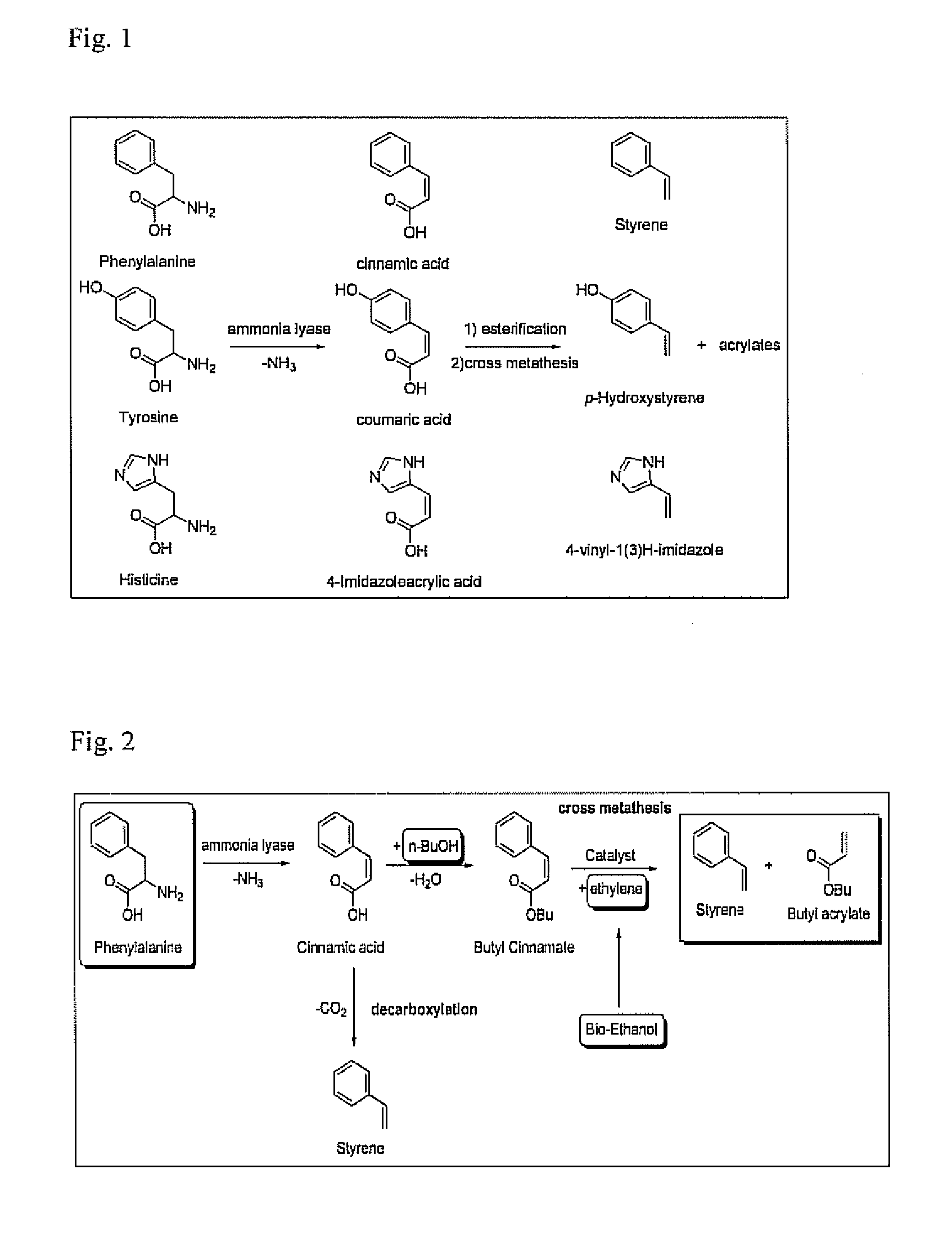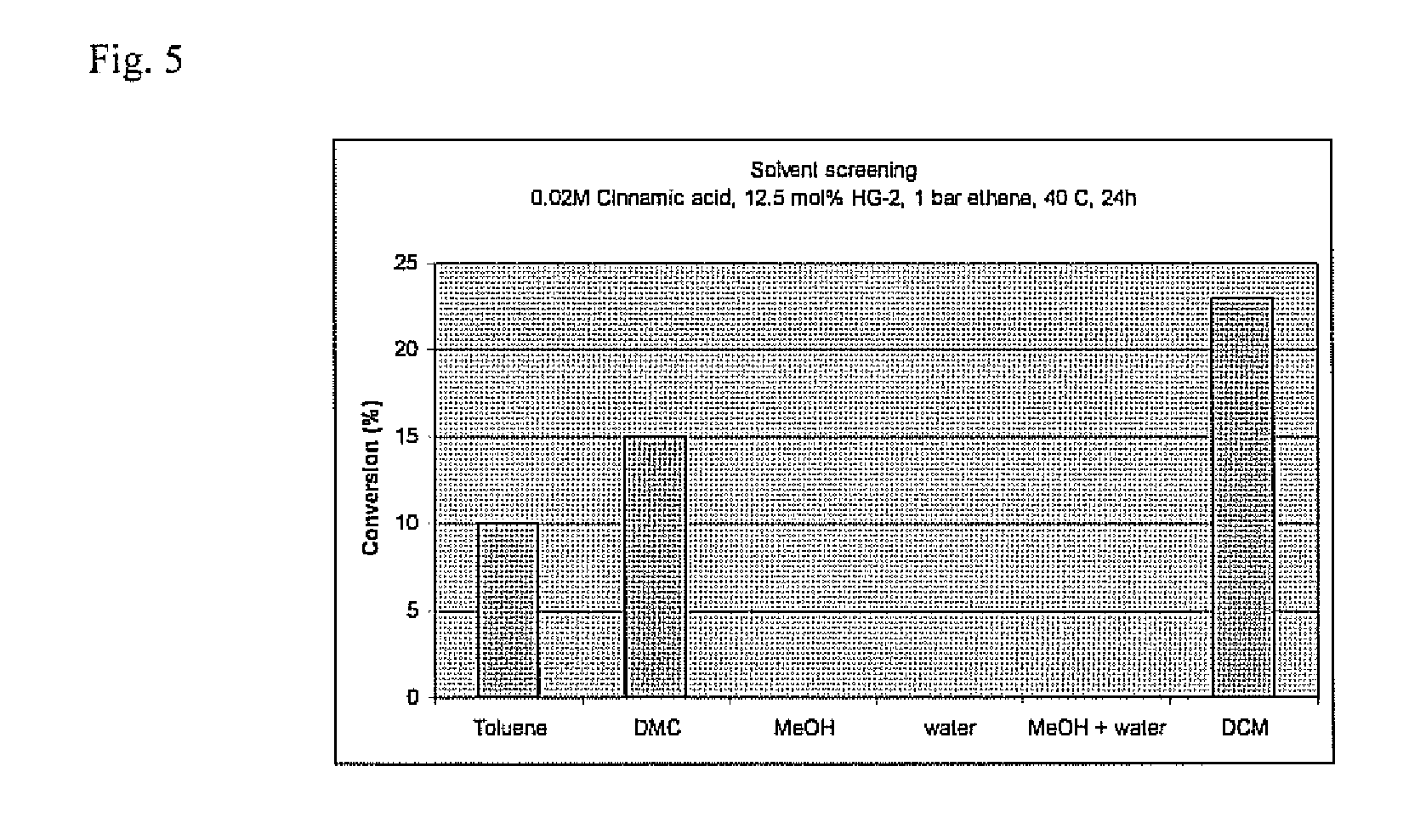Bio-derived olefin synthesis
a technology of olefin and bioderived olefin, which is applied in the direction of hydrocarbon by metathesis reaction, carboxylic compound preparation, hydrocarbon preparation catalyst, etc., can solve the problems of diminishing resources and not renewable, limited production of useful chemicals from biomass in respect of the types of chemicals, and limited production of acrylic acid and/or esters
- Summary
- Abstract
- Description
- Claims
- Application Information
AI Technical Summary
Benefits of technology
Problems solved by technology
Method used
Image
Examples
example 1
[0060]This example demonstrates the conversion of cinnamic acid or its derivatives to styrene and acrylic acid or acrylates.
[0061]To demonstrate the feasibility of converting cinnamic acid or its ester derivatives into styrene and acrylic acid or its esters through the addition of ethene, cross metathesis reactions have been performed using commercially available catalysts. The following results demonstrate the ability of the ethenolysis reaction to take place on these kind of substrates.
[0062]Standard Procedure:
[0063]A stock solution was prepared in a Schlenk tube containing the solvent (e.g. dichloromethane (DCM), toluene, water, methanol, dimethyl carbonate (DMC)) with the substrate (e.g. 0.02-0.25M) and the catalyst (e.g. 5-12.5 mol %). The solution was divided over the reactors using a syringe and the reactors were purged three times with N2. The reactors were placed in the control system and purged three times with ethene. The pressure of ethene was applied and the reaction wa...
example 2
[0084]This example demonstrates the feasibility of the ethenolysis of various enoic acid and enoic ester substrates (cinnamic acid, crotonic acid, ethyl cinnamate, butyl cinnamate) using the optimized reaction conditions.
[0085]The procedure follows the standard procedure described in example 1.
[0086]Results:[0087]Ethenolysis of various enoic acids and esters:
[0088](Reaction conditions: substrate (0.05 M), catalyst HG2 (12.5 mol %), P(ethene)=0.75 bar, DCM (10 mL), 40° C., 24 h)
[0089](For reactions with Pethene below 1 bar, the reaction atmosphere was completed with nitrogen to reach 1 bar)
[0090]Conversion results: Table 6
TABLE 6SubstrateConversion and productsCinnamic acid31% acrylic acid, 5% stilbene, 21% styreneCrotonic Acid50% acrylic acid, (% propene not determined)Ethyl cinnamate28% ethyl acrylate, 4.5% stilbene, 19% styreneButyl cinnamate39% butyl cinnamate, 6.5% stilbene, 26% styrene
example 3
[0091]This example demonstrates the feasibility of a cross-metathesis of various enoic acid and enoic ester substrates (cinnamic acid, crotonic acid, ethyl cinnamate, butyl cinnamate) with 1-butene.
[0092]The procedure follows the standard procedure described in example 1, using 1-butene instead of ethene.
[0093]Results:
[0094]Cross-metathesis of various enoic acids and esters with 1-butene:
[0095](Reaction conditions: substrate (0.05 M), catalyst HG2 (12.5 mol %), P(1-butene)=1.0 bar, DCM (10 mL), 40° C., 24 h)
[0096]Conversion results: Table 7
TABLE 7SubstrateConversion and productsCinnamic acid13% styrene, 13% acrylic acidCrotonic Acid 5% acrylic acid, (% propene not determined)Ethyl cinnamate 8% styrene, 8% ethyl acrylateButyl cinnamate 9% styrene, 9% butyl cinnamate
PUM
| Property | Measurement | Unit |
|---|---|---|
| Volume | aaaaa | aaaaa |
| Volume | aaaaa | aaaaa |
| Fraction | aaaaa | aaaaa |
Abstract
Description
Claims
Application Information
 Login to View More
Login to View More - R&D
- Intellectual Property
- Life Sciences
- Materials
- Tech Scout
- Unparalleled Data Quality
- Higher Quality Content
- 60% Fewer Hallucinations
Browse by: Latest US Patents, China's latest patents, Technical Efficacy Thesaurus, Application Domain, Technology Topic, Popular Technical Reports.
© 2025 PatSnap. All rights reserved.Legal|Privacy policy|Modern Slavery Act Transparency Statement|Sitemap|About US| Contact US: help@patsnap.com



